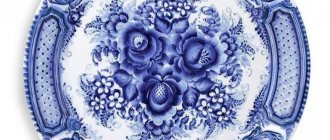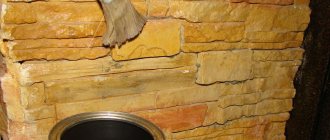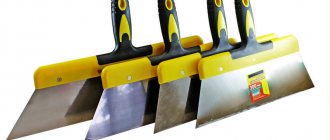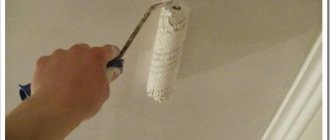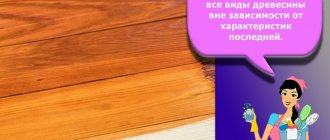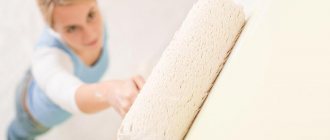Before use, metal structures must be protected from rust. Corrosion renders products unusable, destroying their structure. An anti-corrosion metal primer can be used as a protective layer. However, many craftsmen forget about this composition and apply paint immediately after cleaning the surface.
Anti-corrosion primer for metal
Purpose and application
The composition, intended for priming metal structures, levels and protects the surface of the object from corrosion. This solution is purchased both for application at home and for industrial premises. The advantage of using a primer is that, when applied to metal, it creates a protective film that is resistant to moisture and temperature.
Review of popular manufacturers
The most popular rust primers are from the following companies:
- EVA. This brand produces converters, the components of which must be mixed in proportions of 3 to 100 before application.
- Stainless steel primer. This is an alkyd composition that is suitable for application to corrosive spots, provides increased moisture resistance and insulates the surface well.
- VD. The rust primer forms a dense film and has a matte surface.
- Bark beetle This manufacturer produces effective 3-in-1 products that are easy to use and relatively inexpensive.
There are other manufacturers offering products that differ in composition, price and properties. The choice depends on the preferences of the buyer and the parameters of the part to be processed.
Composition and technical characteristics
The components that make up the priming solution are special substances that can penetrate the metal structure and prevent the oxidation process.
Today, manufacturers offer a wide range of primers suitable for different types of metal surfaces. Priming is the most effective way to protect an object from rust.
Consumption per 1 m2
The priming solution is applied to the metal surface in order to carry out preparatory work for further painting. Pre-treatment allows the paintwork to last much longer. It is very important that the composition complies with GOST. Indicators of mixture quality are:
- Viscosity;
- Density;
- Consumption;
- Drying time.
When covering a metal surface, the consumption per 1 m2 is calculated at a rate of 80 to 120 ml.
Peculiarities
When selecting a priming solution, the buyer must take into account the characteristics of metal surfaces. On the shelves of specialized stores there is a wide selection of products that differ in the type of processing:
- For non-ferrous metals. This composition is applied to an aluminum, copper or brass surface. The product improves adhesion and makes adhesion to the base strong and reliable. Suitable for galvanized steel;
- For ferrous metals. The primer is used for working with cast iron and iron. The solution resists oxidation and rust formation. In addition, the composition increases the adhesion of paintwork materials to the base during finishing painting;
- For galvanizing. The mixture is specially created for working with galvanized steel. It is made on the basis of organic solvents;
- For ferrous metals with traces of corrosion. This product contains components that can react with rust. It restores the surface and does not require preliminary stripping of the metal;
- Special mixtures. Solutions used against certain metal stains. Such primers are intended for application to objects containing soot, traces of grease and other contaminants. Failure to treat the problem surface can cause the paint composition to peel off.
Advantages and disadvantages
Metal processing with a properly selected composition has a number of advantages:
- Saves paint and varnish material;
- Improves the quality of adhesion of paint and metal surfaces;
- Creates a protective layer against corrosion;
- Acrylic primers for metal are absolutely safe for humans and can be used indoors;
- Epoxy primers for metal have high strength properties.
Professionals say that the minimal costs associated with applying primer can delay repair work for a long time.
Powder priming rules
Before protective treatment, old paint and stubborn dirt must be removed from the metal: for good adhesion, the primer must be applied to a clean surface. It is optimal to use the shot blasting cleaning method followed by phosphating and chromating to remove grease and the slightest traces of rust.
You can coat the metal with primer manually, but this is a labor-intensive and uneconomical method. Electrostatic application of primer on a powder painting line significantly reduces work time and reduces material consumption. True, this method is the prerogative of specialized industries.
NAYADA uses powder paints, primers and varnishes from famous world brands. We use advanced technologies and ensure compliance with standards at every stage of the process.
The guarantee against spontaneous peeling of the powder coating for all our products is 3 years. And the service life of the powder decorative protective layer is up to 30 years.
Contact NAYADA for professional powder painting. We have been powder coating metal for over 15 years.
Source
Required tools and materials
Having chosen a primer suitable for metal processing, you need to take into account all its features and select the appropriate tool that will be needed to apply the composition:
- A spray gun will help to coat a metal surface with a large area of paint with a liquid solution. This device is indispensable when working with large iron objects.
- The use of a roller is possible for any type of primer mixture.
- It is not advisable to use a brush as an independent tool - it significantly increases the consumption of material. It is worth giving preference when applying primer in hard-to-reach places.
Attention! Today it is possible to purchase soil in cans. The aerosol composition is very convenient to apply, since it does not require additional tools for work.
Tips and recommendations for use
- Don't buy the first priming mixture you come across. To make the right choice, you need to carefully study all the characteristics of the metal.
- In some cases, for better protection, it is recommended to apply a layer of moisture-proof coating. As a rule, this is done when using a frost-resistant composition that is used to treat objects located in the fresh air.
- Stick to the temperature regime. Regardless of the selected primer, it must be applied at temperatures from -10 to +27 degrees Celsius.
- Despite the specifics of priming, carry out the work wearing personal protective equipment. Take care in advance about purchasing glasses, a respirator and gloves. Wearing protective equipment is extremely important when using a sprayer.
- Observe the operating conditions of the soil, do not use it after its expiration date.
Main types of primers
Let's look at the main types of primers suitable for application to a metal surface.
Phosphating
The basis of the mixture is solvents and orthophosphate acid. This type of primer is a universal solution that is suitable for processing any metal structures. The composition is recommended to be applied to objects not subject to corrosion.
Phosphating primers have good adhesion; when working, they create a porous layer on which the paint and varnish material easily lies. Typically, such solutions are used to treat steel, aluminum and galvanized surfaces.
The compositions combine well with paints that have an alkyd, ethanol and epoxy base. The phosphating primer is highly heat resistant; it can withstand temperatures from +150 to +220 degrees Celsius. After applying the mixture, the surface acquires dielectric properties. The disadvantages of the soil include low anti-corrosion protection.
Passivating
The main components of the composition are chromic acid salts: strontium, barium, calcium, lead, zinc chromates. At the same time, chromates are common passivators. They tend to make the transition of metals from an active state to a passive one. The coating after priming will not interact with the environment.
Attention! A high concentration of chromium salts in the passivation solution is very important, since their deficiency can enhance corrosion processes.
Compositions whose main constituents are dichromate salts are well suited for protecting aluminum structures. When working with ferrous metals, ordinary chromates are sufficient. As a rule, strontium and zinc compounds become components of the passivating primer.
The high concentration of salts provides a high-quality protective coating.
Isolating
The basis of the primer is called neutral pigments, such as red lead, which creates a film on the metal that is resistant to moisture. Unfortunately, the mixture does not last long for this effect and the liquid that seeps through the coating starts the rusting process.
Transformative
A solution for priming metal products can be applied to surfaces containing traces of corrosion. The composition converts rust into a compound that undergoes rapid destruction.
The components of the mixture are surfactants that ensure easy penetration of soil particles through layers of corrosion.
The combination of a transforming composition with a passivating material is optimal.
Tread
Products containing magnesium, zinc and aluminum powders fight rust. The quality of the soil is directly dependent on the concentration of the above components. The higher their number, the better the soil.
The most popular material used for pre-treatment of metal structures is a composition containing zinc dust.
Inhibitory
This metal primer is widely used to protect surfaces from corrosion. The metal processing process creates an enamel primer on the surface of the product. Inhibitors can be soluble in both water and oil.
Alkyd
The product is classified as an insulating and passivating primer. Its main purpose is to combat the effects of corrosion.
The components of the primer are fillers based on red lead, white, etc.
The product is a universal mixture that provides good adhesion to finishing materials. It is possible to use the solution under alkyd paint compositions.
How to prime - stages of work
Priming metal before painting should be accompanied by preliminary sanding of the surface, especially if it is glossy. Grinding should not be confused with polishing - as a result of the former, an even but rough layer is formed, while polishing completely smoothes out even microscopic irregularities. On a polished surface, the soil will adhere much better.
If you are using a composition without transformative properties, then before applying it you should remove any signs of rust from the surface to be painted.
At home, you can use sandpaper for this, or even better, a grinding machine, which will speed up the process significantly. In industrial workshops they use an even faster method - sandblasting. When applying the primer, make sure that there are no bald spots left - a small missed spot can lead to “contamination” of rust on the entire metal structure! After the primer has been applied and completely dried, you can begin to apply the final coat of paint.
It is impossible not to mention the existence of combined options such as primer-enamel “three in one”, which are applied to the rust layer. There are quite a large number of manufacturers who produce excellent compositions of this kind, but when buying even the most expensive “three in one” primer, you must understand that in exchange for speed of work you get a much shorter period of guaranteed protection of the metal from corrosion than with a combined step-by-step processing with different compounds. On average, the service life of primer-enamel is from 5 to 10 years, while combined treatment can increase the service life several times.
Quick-drying primer for metal
There is an opinion that a quick-drying primer is any priming solution that dries quickly. In fact, this statement is only partially true.
A quick-drying primer designed for treating metal surfaces requires from 20 minutes to 12 hours to dry completely. Such mixtures are created on an alkyd basis and include organic solvents. It should be noted that the drying time of conventional alkyd solutions for priming and coloring compounds takes about 2-3 days.
The product is most often used in the following applications:
- Mechanical engineering;
- Shipbuilding;
- Construction;
- Manufacturing of railway and agricultural machinery.
Let's look at the main properties of a quick-drying mixture using the example of GF-021 soil from TEX:
- Corrosion protection. The anti-corrosion qualities of the composition create a film that prevents the occurrence of rust, which is the main feature of the primer;
- Good adhesion. Preliminary use of the composition before painting can significantly improve the adhesion of paintwork materials to the base;
- Weather resistant. For some phenomena the function is not long-term, for this reason the application of the paint and varnish material should not be seriously delayed;
- Chemical resistance. The coating withstands exposure to substances such as oil, salt, gasoline, etc.;
- Covering power. The composition ensures uniform application of color to the working surface;
- Versatility. The quick-drying primer is suitable for both outdoor work and indoor painting. It can be used on surfaces made of metal, wood, concrete;
- Strong smell. The mixture has a pungent odor, which is caused by the organic solvents included in the composition. Due to this feature, it is necessary to use personal protective equipment when working.
How to paint galvanized steel correctly so that it does not peel off for as long as possible
Before using primer and paint on galvanized metal car, prepare the surface:
- Clean car parts from dust, dirt, and traces of corrosion. To do this, use sandblasting equipment, sandpaper, and soap solution.
- Then degrease the surface using low concentration phosphoric acid or a mixture of acetone and toluene in a ratio of 1 to 1. It is permissible to degrease the coating with kerosene, white spirit, or chlorine-containing bleach.
Immediately after completing these steps and the applied products have dried, paint the surface. It is recommended to carry out the final painting within 30 minutes after you have primed the car. This will increase the adhesive properties of the material and also provide high-quality coating. To achieve maximum results, it is recommended to apply 2-3 layers of finishing paint.


